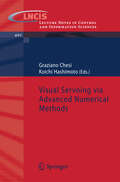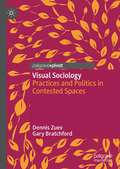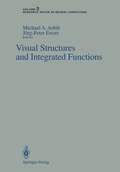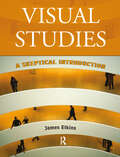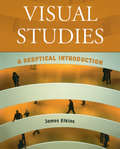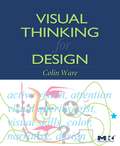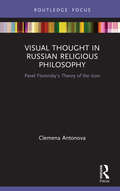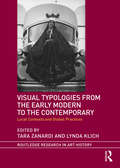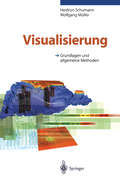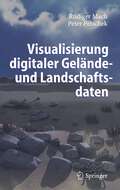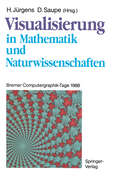- Table View
- List View
Visual Servoing via Advanced Numerical Methods (Lecture Notes in Control and Information Sciences #401)
by Graziano Chesi Koichi HashimotoRobots able to imitate human beings have been at the core of stories of science?ctionaswellasdreamsofinventorsforalongtime.Amongthe various skills that Mother Nature has provided us with and that often go forgotten, the ability of sight is certainly one of the most important. Perhaps inspired by tales of Isaac Asimov, comics and cartoons, and surely helped by the progress of electronics in recent decades, researchers have progressively made the dream of creating robots able to move and operate by exploiting arti?cial vision a concrete reality. Technically speaking, we would say that these robots position themselves and their end-e?ectors by using the view provided by some arti?cial eyes as feedback information. Indeed, the arti?cial eyes are visual sensors such as cameras that have the function to acquire an image of the environment. Such an image describes if and how the robot is moving toward the goal and hence constitutes feedback information. This procedure is known in robotics with the term visual servoing, and it is nothing else than an imitation of the intrinsic mechanism that allows human beings to realize daily tasks such as reaching the door of the house or grasping a cup of co?ee.
Visual Signal Quality Assessment: Quality of Experience (QoE)
by Chenwei Deng Lin Ma Weisi Lin King Ngi NganThis book provides comprehensive coverage of the latest trends/advances in subjective and objective quality evaluation for traditional visual signals, such as 2D images and video, as well as the most recent challenges for the field of multimedia quality assessment and processing, such as mobile video and social media. Readers will learn how to ensure the highest storage/delivery/ transmission quality of visual content (including image, video, graphics, animation, etc.) from the server to the consumer, under resource constraints, such as computation, bandwidth, storage space, battery life, etc.
Visual Sociology: Practices and Politics in Contested Spaces (Routledge Advances In Sociology Ser. #91)
by Dennis Zuev Gary BratchfordThis book provides a user-friendly guide to the expanding scope of visual sociology, through a discussion of a broad range of visual material, and reflections on how such material can be studied sociologically. The chapters draw on specific case-study examples that examine the complexity of the hyper-visual social world we live in, exploring three domains of the ‘relational image’: the urban, social media, and the aerial. Zuev and Bratchford tackle issues such as visual politics and surveillance, practices of visual production and visibility, analysing the changing nature of the visual. They review a range of methods which can be used by researchers in the social sciences, utilising new media and their visual interfaces, while also assessing the changing nature of visuality. This concise overview will be of use to students and researchers aiming to adopt visual methods and theories in their own subject areas such as sociology, visual culture and related courses in photography, new-media and visual studies.
Visual Spatial Enquiry: Diagrams and Metaphors for Architects and Spatial Thinkers (Routledge Research in Architecture)
by Robyn Creagh Sarah McGannVisual Spatial Enquiry explores visual and textual ways of working within spatial research. Architects and spatial thinkers from the arts, social sciences and humanities present rich case studies from remote and regional settings in Australia to the suburbs of Los Angeles, and from gallery and university settings to community collaborations in Mongolia. Through these case studies the authors reappraise and reconsider research approaches, methods and processes within and across their fields. In spatial research diagramming can be used as a method to synthesise complex concepts into a succinct picture, whereas metaphors can add the richness of lived experiences. Drawing on the editors’ own architectural backgrounds, this volume is organised into three key themes: seeing, doing and making space. In seeing space chapters consider observational research enquiries where developing empathy for the context and topic is as important as gathering concrete data. Doing space explores generative opportunities that inform new and innovative propositions, and making space looks at ways to rethink and reshape spatial and relational settings. Through this volume Creagh and McGann invite readers to find their own understandings of the value and practices of neighbouring fields including planning, geography, ethnography, architecture and art. This exploration will be of value to researchers looking to develop their cross-disciplinary literacy, and to design practitioners looking to enhance and articulate their research skills.
Visual Spatial Enquiry: Diagrams and Metaphors for Architects and Spatial Thinkers (Routledge Research in Architecture)
by Robyn Creagh Sarah McGannVisual Spatial Enquiry explores visual and textual ways of working within spatial research. Architects and spatial thinkers from the arts, social sciences and humanities present rich case studies from remote and regional settings in Australia to the suburbs of Los Angeles, and from gallery and university settings to community collaborations in Mongolia. Through these case studies the authors reappraise and reconsider research approaches, methods and processes within and across their fields. In spatial research diagramming can be used as a method to synthesise complex concepts into a succinct picture, whereas metaphors can add the richness of lived experiences. Drawing on the editors’ own architectural backgrounds, this volume is organised into three key themes: seeing, doing and making space. In seeing space chapters consider observational research enquiries where developing empathy for the context and topic is as important as gathering concrete data. Doing space explores generative opportunities that inform new and innovative propositions, and making space looks at ways to rethink and reshape spatial and relational settings. Through this volume Creagh and McGann invite readers to find their own understandings of the value and practices of neighbouring fields including planning, geography, ethnography, architecture and art. This exploration will be of value to researchers looking to develop their cross-disciplinary literacy, and to design practitioners looking to enhance and articulate their research skills.
The Visual Story: Creating the Visual Structure of Film, TV and Digital Media
by Bruce BlockIf you can't make it to one of Bruce Block's legendary visual storytelling seminars, then you need his book! Now in full color for the first time, this best-seller offers a clear view of the relationship between the story/script structure and the visual structure of a film, video, animated piece, or video game. You'll learn how to structure your visuals as carefully as a writer structures a story or a composer structures music. Understanding visual structure allows you to communicate moods and emotions, and most importantly, reveals the critical relationship between story structure and visual structure.The concepts in this book will benefit writers, directors, photographers, production designers, art directors, and editors who are always confronted by the same visual problems that have faced every picture maker in the past, present, and future.
The Visual Story: Creating the Visual Structure of Film, TV and Digital Media
by Bruce BlockIf you can't make it to one of Bruce Block's legendary visual storytelling seminars, then you need his book! Now in full color for the first time, this best-seller offers a clear view of the relationship between the story/script structure and the visual structure of a film, video, animated piece, or video game. You'll learn how to structure your visuals as carefully as a writer structures a story or a composer structures music. Understanding visual structure allows you to communicate moods and emotions, and most importantly, reveals the critical relationship between story structure and visual structure.The concepts in this book will benefit writers, directors, photographers, production designers, art directors, and editors who are always confronted by the same visual problems that have faced every picture maker in the past, present, and future.
The Visual Story: Creating the Visual Structure of Film, TV, and Digital Media
by Bruce BlockThis updated edition of a best-selling classic shows you how to structure your visuals as carefully as a writer structures a story or composers structure their music. The Visual Story teaches you how to design and control the structure of your production using the basic visual components of space, line, shape, tone, color, movement, and rhythm. You can use these components to effectively convey moods and emotions, create a visual style, and utilize the important relationship between the visual and the story structures. Using over 700 color illustrations, author Bruce Block explains how understanding the connection between story and visual structures will guide you in the selection of camera angles, lenses, actor staging, composition, set design and locations, lighting, storyboard planning, camera coverage, and editing. The Visual Story is an ideal blend of theory and practice. The concepts and examples in this new edition will benefit students learning cinematic production, as well as professional writers, directors, cinematographers, art directors, animators, game designers, and anyone working in visual media who wants a better understanding of visual structure.
The Visual Story: Creating the Visual Structure of Film, TV, and Digital Media
by Bruce BlockThis updated edition of a best-selling classic shows you how to structure your visuals as carefully as a writer structures a story or composers structure their music. The Visual Story teaches you how to design and control the structure of your production using the basic visual components of space, line, shape, tone, color, movement, and rhythm. You can use these components to effectively convey moods and emotions, create a visual style, and utilize the important relationship between the visual and the story structures. Using over 700 color illustrations, author Bruce Block explains how understanding the connection between story and visual structures will guide you in the selection of camera angles, lenses, actor staging, composition, set design and locations, lighting, storyboard planning, camera coverage, and editing. The Visual Story is an ideal blend of theory and practice. The concepts and examples in this new edition will benefit students learning cinematic production, as well as professional writers, directors, cinematographers, art directors, animators, game designers, and anyone working in visual media who wants a better understanding of visual structure.
Visual Structures and Integrated Functions (Research Notes in Neural Computing #3)
by Michael A. Arbib Jörg-Peter EwertThis volume integrates theory and experiment to place the study of vision within the context of the action systems which use visual information. This theme is developed by stressing: (a) The importance of situating anyone part of the brain in the context of its interactions with other parts of the brain in subserving animal behavior. The title of this volume emphasizes that visual function is to be be viewed in the context of the integrated functions of the organism. (b) Both the intrinsic interest of frog and toad as animals in which to study the neural mechanisms of visuomotor coordination, and the importance of comparative studies with other organisms so that we may learn from an analysis of both similarities and differences. The present volume thus supplements our studies of frog and toad with papers on salamander, bird and reptile, turtle, rat, gerbil, rabbit, and monkey. (c) Perhaps most distinctively, the interaction between theory and experiment.
Visual Studies: A Skeptical Introduction
by James ElkinsIn his latest book, James Elkins offers a road map through the field of visual studies, describing its major concerns and its principal theoretical sources. Then, with the skill and insight that have marked his successful books on art and visuality, Elkins takes the reader down a side road where visual studies can become a more interesting place. Why look only at the same handful of theorists? Why exclude from one's field of vision non-Western art or the wealth of scientific images?
Visual Studies: A Skeptical Introduction
by James ElkinsIn his latest book, James Elkins offers a road map through the field of visual studies, describing its major concerns and its principal theoretical sources. Then, with the skill and insight that have marked his successful books on art and visuality, Elkins takes the reader down a side road where visual studies can become a more interesting place. Why look only at the same handful of theorists? Why exclude from one's field of vision non-Western art or the wealth of scientific images?
Visual Synergies in Fiction and Documentary Film from Latin America (Studies of the Americas)
by M. Haddu J. PageThis collection brings together leading international scholars and filmmakers focusing on Latin American cinema. Themes discussed include subjectivity, history, memory, representations of reality, cinema's relation to the public sphere, and issues of production, distribution and marketing.
Visual Texture: Accurate Material Appearance Measurement, Representation and Modeling (Advances in Computer Vision and Pattern Recognition)
by Michal Haindl Jiri FilipThis book surveys the state of the art in multidimensional, physically-correct visual texture modeling. Features: reviews the entire process of texture synthesis, including material appearance representation, measurement, analysis, compression, modeling, editing, visualization, and perceptual evaluation; explains the derivation of the most common representations of visual texture, discussing their properties, advantages, and limitations; describes a range of techniques for the measurement of visual texture, including BRDF, SVBRDF, BTF and BSSRDF; investigates the visualization of textural information, from texture mapping and mip-mapping to illumination- and view-dependent data interpolation; examines techniques for perceptual validation and analysis, covering both standard pixel-wise similarity measures and also methods of visual psychophysics; reviews the applications of visual textures, from visual scene analysis in medical applications, to high-quality visualizations in the automotive industry.
Visual Thinking for Design
by Colin WareVisual Thinking brings the science of perception to the art of design. Designers increasingly need to present information in ways that aid their audience’s thinking process. Fortunately, results from the relatively new science of human visual perception provide valuable guidance. In this book, Colin Ware takes what we now know about perception, cognition, and attention and transforms it into concrete advice that designers can directly apply. He demonstrates how designs can be considered as tools for cognition – extensions of the viewer’s brain in much the same way that a hammer is an extension of the user’s hand. The book includes hundreds of examples, many in the form of integrated text and full-color diagrams. Experienced professional designers and students alike will learn how to maximize the power of the information tools they design for the people who use them.Presents visual thinking as a complex process that can be supported in every stage using specific design techniquesProvides practical, task-oriented information for designers and software developers charged with design responsibilitiesIncludes hundreds of examples, many in the form of integrated text and full-color diagramsSteeped in the principles of “active vision," which views graphic designs as cognitive tools
Visual Thought in Russian Religious Philosophy: Pavel Florensky's Theory of the Icon (Routledge Focus on Religion)
by Clemena AntonovaThis book considers a movement within Russian religious philosophy known as "full unity" (vseedinstvo), with a focus on one of its main representatives, Pavel Florensky (1882–1937). Often referred to as "the Russian Leonardo," Florensky was an important figure of the Russian religious renaissance around the beginning of the twentieth century. This book shows that his philosophy, conceptualized in his theory of the icon, brings together the problem of the "religious turn" and the "pictorial turn" in modern culture, as well as contributing to contemporary debates on religion and secularism. Organized around the themes of full unity and visuality, the book examines Florensky’s definition of the icon as "energetic symbol," drawing on St. Gregory Palamas, before offering a theological reading of Florensky’s theory of the pictorial space of the icon. It then turns to Florensky’s idea of space in the icon as Non-Euclidean. Finally, the icon is placed within wider debates provoked by Bolshevik cultural policy, which extend to current discussions concerning religion, modernity, and art. Offering an important contribution from Russian religious philosophy to issues of contemporary modernity, this book will be of interest to scholars of religious philosophy, Russian studies, theology and the arts, and the medieval icon.
Visual Thought in Russian Religious Philosophy: Pavel Florensky's Theory of the Icon (Routledge Focus on Religion)
by Clemena AntonovaThis book considers a movement within Russian religious philosophy known as "full unity" (vseedinstvo), with a focus on one of its main representatives, Pavel Florensky (1882–1937). Often referred to as "the Russian Leonardo," Florensky was an important figure of the Russian religious renaissance around the beginning of the twentieth century. This book shows that his philosophy, conceptualized in his theory of the icon, brings together the problem of the "religious turn" and the "pictorial turn" in modern culture, as well as contributing to contemporary debates on religion and secularism. Organized around the themes of full unity and visuality, the book examines Florensky’s definition of the icon as "energetic symbol," drawing on St. Gregory Palamas, before offering a theological reading of Florensky’s theory of the pictorial space of the icon. It then turns to Florensky’s idea of space in the icon as Non-Euclidean. Finally, the icon is placed within wider debates provoked by Bolshevik cultural policy, which extend to current discussions concerning religion, modernity, and art. Offering an important contribution from Russian religious philosophy to issues of contemporary modernity, this book will be of interest to scholars of religious philosophy, Russian studies, theology and the arts, and the medieval icon.
Visual Typologies from the Early Modern to the Contemporary: Local Contexts and Global Practices (Routledge Research in Art History)
by Tara Zanardi and Lynda KlichVisual Typologies from the Early Modern to the Contemporary investigates the pictorial representation of types from the sixteenth to the twenty- first century. Originating in longstanding visual traditions, including street crier prints and costume albums, these images share certain conventions as they seek to convey knowledge about different peoples. The genre of the type became widespread in the early modern period, developing into a global language of identity. The chapters explore diverse pictorial representations of types, customs, and dress in numerous media, including paintings, prints, postcards, photographs, and garments. Together, they reveal that the activation of typological strategies, including seriality, repetition, appropriation, and subversion has produced a universal and dynamic pictorial language. Typological images highlight the tensions between the local and the international, the specific and the communal, and similarity and difference inherent in the construction of identity. The first full- length study to treat these images as a broader genre, Visual Typologies gives voice to a marginalized form of representation. Together, the chapters debunk the classification of such images as unmediated and authentic representations, offering fresh methodological frameworks to consider their meanings locally and globally, and establishing common ground about the operations of objects that sought to shape, embody, or challenge individual and collective identities.
Visual Typologies from the Early Modern to the Contemporary: Local Contexts and Global Practices (Routledge Research in Art History)
by Tara Zanardi Lynda KlichVisual Typologies from the Early Modern to the Contemporary investigates the pictorial representation of types from the sixteenth to the twenty- first century. Originating in longstanding visual traditions, including street crier prints and costume albums, these images share certain conventions as they seek to convey knowledge about different peoples. The genre of the type became widespread in the early modern period, developing into a global language of identity. The chapters explore diverse pictorial representations of types, customs, and dress in numerous media, including paintings, prints, postcards, photographs, and garments. Together, they reveal that the activation of typological strategies, including seriality, repetition, appropriation, and subversion has produced a universal and dynamic pictorial language. Typological images highlight the tensions between the local and the international, the specific and the communal, and similarity and difference inherent in the construction of identity. The first full- length study to treat these images as a broader genre, Visual Typologies gives voice to a marginalized form of representation. Together, the chapters debunk the classification of such images as unmediated and authentic representations, offering fresh methodological frameworks to consider their meanings locally and globally, and establishing common ground about the operations of objects that sought to shape, embody, or challenge individual and collective identities.
Visual Typologies from the Early Modern to the Contemporary: Local Contexts and Global Practices (Routledge Research in Art History)
by Tara Zanardi Lynda KlichVisual Typologies from the Early Modern to the Contemporary investigates the pictorial representation of types from the sixteenth to the twenty- first century. Originating in longstanding visual traditions, including street crier prints and costume albums, these images share certain conventions as they seek to convey knowledge about different peoples. The genre of the type became widespread in the early modern period, developing into a global language of identity. The chapters explore diverse pictorial representations of types, customs, and dress in numerous media, including paintings, prints, postcards, photographs, and garments. Together, they reveal that the activation of typological strategies, including seriality, repetition, appropriation, and subversion has produced a universal and dynamic pictorial language. Typological images highlight the tensions between the local and the international, the specific and the communal, and similarity and difference inherent in the construction of identity. The first full- length study to treat these images as a broader genre, Visual Typologies gives voice to a marginalized form of representation. Together, the chapters debunk the classification of such images as unmediated and authentic representations, offering fresh methodological frameworks to consider their meanings locally and globally, and establishing common ground about the operations of objects that sought to shape, embody, or challenge individual and collective identities.
Visualisierung digitaler Gelände- und Landschaftsdaten
by Rüdiger Mach Peter PetschekOft wirken erste Gehversuche mit 3D-Visualisierung zu technisch. Stimmung und Atmosphäre werden nicht kommuniziert. Das ist frustrierend und führt dazu, dass gerne zu alt bekannten Kollagetechniken für eine Präsentation gegriffen wird. Die technologischen Entwicklungen im Umfeld der Computergrafik bieten jedoch Möglichkeiten, die mit klassischen Methoden nie erreicht werden. Dies ist einer der Schwerpunkte dieses Buches. Vor dem Hintergrund der Anforderungen des Planungswesens und den Ansprüchen realer Planungsdaten vermitteln die Autoren den Umgang mit digitaler Technik zur Erstellung ansprechender Visualisierungen rund um digitale Landschaften. Alles was Sie als Architekt, Bauingeniur, Planer und Landschaftsarchitekt schon immer zum Thema Visualisierung Digitaler Gelände- und Landschaftsdaten wissen wollten, finden Sie in diesem Buch. Es handelt sich um ein Buch von Praktikern für Praktiker.
Visualisierung in Mathematik und Naturwissenschaften: Bremer Computergraphik-Tage 1988
by Hartmut Jürgens Dietmar SaupeDas Buch gibt einen Querschnitt durch das Spektrum der Anwendungen der Computergraphik in Mathematik und Naturwissenschaften. Dabei werden auch neue computergraphische Algorithmen, komplexe Anwenderpakete und sogar Hardwarelösungen diskutiert. Die Beiträge in diesem Band, die auf Vorträgen der ersten Bremer Computer-Graphik-Tage vom Juli 1988 basieren, sind entsprechend vielfältig: Sie reichen von der Berechnung und Visualisierung mathematischer Objekte und Fraktale über Probleme des Medical Imaging bei der Darstellung volumetrischer Daten, Untersuchungen von Oberflächentexturen für Bildsynthese bis hin zur Diskussion verschiedener Ansätze der Parallelisierung computergraphischer Algorithmen. Bei der Darstellung neuer Lösungswege für komplexe Probleme der Visualisierung wurde besonderer Wert auf die praktischen Details gelegt, so daß der interessierte Leser diese Lösungen auch in einer eigenen Implementierung nachvollziehen kann.
Visualisierung meteorologischer Daten (Beiträge zur Graphischen Datenverarbeitung)
by Florian SchröderDie professionelle Visualisierung meteorologischer Daten aus Observationen und Simulaltionen für ein Laienpublikum über Fernsehen, Presse, Online-Dienste und Meteorologen wird in diesem Band beschrieben. Neue Konzepte und Verfahren erlauben eine umfassende Berücksichtigung des Kontextes: Die Zielgruppe bestimmt maßgeblich die Auswahl und Parametrisierung der Visualisierungstechniken. Das ausführlich dargestellte automatisierte Produktionssystem zur Erstellung von Fernsehwettervorhersagen erzeugt Filme in Broadcastqualität, die komplexe Informationen in attraktiven und stets intuitiv verständlichen zwei- oder dreidimensionalen Bildern beinhalten.
